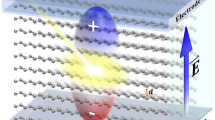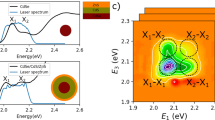Abstract
Understanding charge transport and recombination dynamics in photoexcited colloidal quantum dot (QD) solids is key to their applications in optoelectronic devices. Towards this end, we conduct transient photocurrent studies of films of electronically coupled, device-grade PbSe QD films. We observe that the photocurrent amplitude detected following excitation with a short 100 fs pulse is virtually temperature independent down to 6 K, suggesting a tunnelling mechanism of early-time photoconductance. The later-time signal exhibits clear signatures of thermal activation with characteristic energies that are surprisingly robust and independent of the exact type of QD surface treatment. We attribute this behaviour to the involvement of intrinsic fine-structure states and specifically the electron–hole exchange interaction, which creates an energetic barrier to electron–hole separation between adjacent QDs. At room temperature, which is well above the largest activation energy, relaxation of photoconductivity is dominated by non-geminate recombination involving mobile band-edge carriers of one sign and low-mobility carriers of the opposite sign (pre-existing and photoexcited) residing in intragap states. This process leads to memory-less dynamics when the photocurrent relaxation time is directly linked to the instantaneous carrier density.
This is a preview of subscription content, access via your institution
Access options
Access Nature and 54 other Nature Portfolio journals
Get Nature+, our best-value online-access subscription
$29.99 / 30 days
cancel any time
Subscribe to this journal
Receive 12 print issues and online access
$209.00 per year
only $17.42 per issue
Buy this article
- Purchase on Springer Link
- Instant access to full article PDF
Prices may be subject to local taxes which are calculated during checkout




Similar content being viewed by others
References
Kovalenko, M. V. et al. Prospects of nanoscience with nanocrystals. ACS Nano 9, 1012–1057 (2015).
Pietryga, J. I. et al. Spectroscopic and device aspects of nanocrystal quantum dots. Chem. Rev. 116, 10513–10622 (2016).
Colvin, V., Schlamp, M. & Alivisatos, A. P. Light-emitting diodes made from cadmium selenide nanocrystals and a semiconducting polymer. Nature 370, 354–357 (1994).
Coe, S., Woo, W.-K., Bawendi, M. & Bulovic, V. Electroluminescence from single monolayers of nanocrystals in molecular organic devices. Nature 420, 800–803 (2002).
Dai, X. et al. Solution-processed, high-performance light-emitting diodes based on quantum dots. Nature 515, 96–99 (2014).
Gur, I., Fromer, N. A., Geier, M. L. & Alivisatos, A. P. Air-stable all-inorganic nanocrystal solar cells processed from solution. Science 310, 462–465 (2005).
Semonin, O. E. et al. Peak external photocurrent quantum efficiency exceeding 100% via MEG in a quantum dot solar cell. Science 334, 1530–1533 (2011).
Sargent, E. H. Colloidal quantum dot solar cells. Nat. Photon. 6, 133–135 (2012).
Konstantatos, G. et al. Ultrasensitive solution-cast quantum dot photodetectors. Nature 442, 180–183 (2006).
Pal, B. N. et al. High-sensitivity p–n junction photodiodes based on PbS nanocrystal quantum dots. Adv. Funct. Mater. 22, 1741–1748 (2012).
Harman, T., Taylor, P., Walsh, M. & LaForge, B. Quantum dot superlattice thermoelectric materials and devices. Science 297, 2229–2232 (2002).
Talapin, D. V. & Murray, C. B. PbSe nanocrystal solids for n- and p-channel thin film field-effect transistors. Science 310, 86–89 (2005).
Liu, Y. et al. Dependence of carrier mobility on nanocrystal size and ligand length in PbSe nanocrystal solids. Nano Lett. 10, 1960–1969 (2010).
Choi, J.-H. et al. Bandlike transport in strongly coupled and doped quantum dot solids: a route to high-performance thin-film electronics. Nano Lett. 12, 2631–2638 (2012).
Lee, J.-S., Kovalenko, M. V., Huang, J., Chung, D. S. & Talapin, D. V. Band-like transport, high electron mobility and high photoconductivity in all-inorganic nanocrystal arrays. Nat. Nanotech. 6, 348–352 (2011).
Liu, Y. et al. Robust, functional nanocrystal solids by infilling with atomic layer deposition. Nano Lett. 11, 5349–5355 (2011).
Guyot-Sionnest, P. Electrical transport in colloidal quantum dot films. J. Phys. Chem. Lett. 3, 1169–1175 (2012).
Nagpal, P. & Klimov, V. I. Role of mid-gap states in charge transport and photoconductivity in semiconductor nanocrystal films. Nat. Commun. 2, 486 (2011).
Bozyigit, D., Volk, S., Yarema, O. & Wood, V. Quantification of deep traps in nanocrystal solids, their electronic properties, and their influence on device behaviour. Nano Lett. 13, 5284–5288 (2013).
Gao, J. & Johnson, J. C. Charge trapping in bright and dark states of coupled PbS quantum dot films. ACS Nano 6, 3292–3303 (2012).
Hwang, G. W. et al. Identifying and eliminating emissive sub-bandgap states in thin films of PbS nanocrystals. Adv. Mater. 27, 4481–4486 (2015).
Diaconescu, B., Padilha, L. A., Nagpal, P., Swartzentruber, B. S. & Klimov, V. I. Measurement of electronic states of PbS nanocrystal quantum dots using scanning tunnelling spectroscopy: the role of parity selection rules in optical absorption. Phys. Rev. Lett. 110, 127406 (2013).
Rath, A. K. et al. Remote trap passivation in colloidal quantum dot bulk nano-heterojunctions and its effect in solution-processed solar cells. Adv. Mater. 26, 4741–4747 (2014).
Yuan, M., Liu, M. & Sargent, E. H. Colloidal quantum dot solids for solution-processed solar cells. Nat. Energy 1, 16016 (2016).
Kang, I. & Wise, F. W. Electronic structure and optical properties of PbS and PbSe quantum dots. J. Opt. Soc. Am. B 14, 1632–1646 (1997).
Nirmal, M. et al. Observation of the “dark exciton” in CdSe quantum dots. Phys. Rev. Lett. 75, 3728 (1995).
An, J. M., Franceschetti, A. & Zunger, A. The excitonic exchange splitting and radiative lifetime in PbSe quantum dots. Nano Lett. 7, 2129–2135 (2007).
Tischler, J. G. et al. Band-edge excitons in PbSe nanocrystals and nanorods. Phys. Rev. B 82, 245303 (2010).
Auston, D. H. Impulse-response of photoconductors in transmission-lines. IEEE J. Quantum Electron. 19, 639–648 (1983).
Gao, J., Fidler, A. F. & Klimov, V. I. Carrier multiplication detected through transient photocurrent in device-grade films of lead selenide quantum dots. Nat. Commun. 6, 8185 (2015).
Nozik, A. J. Quantum dot solar cells. Physica E 14, 115–120 (2002).
Schaller, R. D. & Klimov, V. I. High efficiency carrier multiplication in PbSe nanocrystals: implications for solar energy conversion. Phys. Rev. Lett. 92, 186601 (2004).
Luther, J. M. et al. Multiple exciton generation in films of electronically coupled PbSe quantum dots. Nano Lett. 7, 1779–1784 (2007).
Smith, C. & Binks, D. Multiple exciton generation in colloidal nanocrystals. Nanomaterials 4, 19–45 (2014).
Klimov, V. I., Mikhailovsky, A. A., McBranch, D. W., Leatherdale, C. A. & Bawendi, M. G. Quantization of multiparticle Auger rates in semiconductor quantum dots. Science 287, 1011–1013 (2000).
Robel, I., Gresback, R., Kortshagen, U., Schaller, R. D. & Klimov, V. I. Universal size-dependent trend in Auger recombination in direct-gap and indirect-gap semiconductor nanocrystals. Phys. Rev. Lett. 102, 177404 (2009).
McGuire, J. A., Sykora, M., Joo, J., Pietryga, J. P. & Klimov, V. I. Apparent versus true carrier multiplication yields in semiconductor nanocrystals. Nano Lett. 10, 2049–2057 (2010).
Kang, M. S., Lee, J., Norris, D. J. & Frisbie, C. D. High carrier densities achieved at low voltages in ambipolar PbSe nanocrystal thin-film transistors. Nano Lett. 9, 3848–3852 (2009).
Ip, A. H. et al. Hybrid passivated colloidal quantum dot solids. Nat. Nanotech. 7, 577–582 (2012).
Schaller, R. D. et al. Revealing the exciton fine structure of PbSe nanocrystal quantum dots using optical spectroscopy in high magnetic fields. Phys. Rev. Lett. 105, 067403 (2010).
Neo, D. C. J. et al. Influence of shell thickness and surface passivation on PbS/CdS core/shell colloidal quantum dot solar cells. Chem. Mater. 26, 4004–4013 (2014).
Kang, M. S., Sahu, A., Norris, D. J. & Frisbie, C. D. Size-and temperature-dependent charge transport in PbSe nanocrystal thin films. Nano Lett. 11, 3887–3892 (2011).
Yu, D., Wang, C., Wehrenberg, B. L. & Guyot-Sionnest, P. Variable range hopping conduction in semiconductor nanocrystal solids. Phys. Rev. Lett. 92, 216802 (2004).
Schaller, R. D. et al. Breaking the phonon bottleneck in semiconductor nanocrystals via multiphonon emission induced by intrinsic nonadiabatic interactions. Phys. Rev. Lett. 95, 196401 (2005).
Merkulov, I. A., Efros, Al. L. & Rosen, M. Electron spin relaxation by nuclei in semiconductor quantum dots. Phys. Rev. B 65, 205309 (2002).
Bae, W. K. et al. Highly effective surface passivation of PbSe quantum dots through reaction with molecular chlorine. J. Am. Chem. Soc. 134, 20160–20168 (2012).
Gao, J. et al. Quantum dot size dependent J–V characteristics in heterojunction Zn/O/PbS quantum dot solar cells. Nano Lett. 11, 1002–1008 (2011).
Acknowledgements
J.G. and V.I.K. acknowledge the support of the Centre for Advanced Solar Photophysics (CASP), an Energy Frontier Research Centre funded by the US Department of Energy, Office of Science, Office of Basic Energy Sciences. A.F.F. is a CASP member supported by a LANL Director’s Postdoctoral Fellowship. We would like to thank our CASP collaborator A. Marshall for providing samples of MPA-treated PbSe QDs.
Author information
Authors and Affiliations
Contributions
J.G. fabricated the devices. J.G. and A.F.F. performed the experiments. A.F.F. and V.I.K. analysed the data and developed the models. A.F.F. and V.I.K. wrote the manuscript.
Corresponding author
Ethics declarations
Competing interests
The authors declare no competing financial interests.
Supplementary information
Supplementary information
Supplementary information (PDF 1148 kb)
Rights and permissions
About this article
Cite this article
Fidler, A., Gao, J. & Klimov, V. Electron–hole exchange blockade and memory-less recombination in photoexcited films of colloidal quantum dots. Nature Phys 13, 604–610 (2017). https://doi.org/10.1038/nphys4073
Received:
Accepted:
Published:
Issue Date:
DOI: https://doi.org/10.1038/nphys4073



